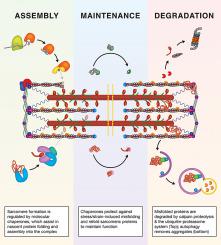Journal of Molecular and Cellular Cardiology ( IF 4.9 ) Pub Date : 2020-09-10 , DOI: 10.1016/j.yjmcc.2020.08.018 Thomas G Martin 1 , Jonathan A Kirk 1

|
The sarcomere is the basic contractile unit of striated muscle and is a highly ordered protein complex with the actin and myosin filaments at its core. Assembling the sarcomere constituents into this organized structure in development, and with muscle growth as new sarcomeres are built, is a complex process coordinated by numerous factors. Once assembled, the sarcomere requires constant maintenance as its continuous contraction is accompanied by elevated mechanical, thermal, and oxidative stress, which predispose proteins to misfolding and toxic aggregation. To prevent protein misfolding and maintain sarcomere integrity, the sarcomere is monitored by an assortment of protein quality control (PQC) mechanisms. The need for effective PQC is heightened in cardiomyocytes which are terminally differentiated and must survive for many years while preserving optimal mechanical output. To prevent toxic protein aggregation, molecular chaperones stabilize denatured sarcomere proteins and promote their refolding. However, when old and misfolded proteins cannot be salvaged by chaperones, they must be recycled via degradation pathways: the calpain and ubiquitin-proteasome systems, which operate under basal conditions, and the stress-responsive autophagy-lysosome pathway. Mutations to and deficiency of the molecular chaperones and associated factors charged with sarcomere maintenance commonly lead to sarcomere structural disarray and the progression of heart disease, highlighting the necessity of effective sarcomere PQC for maintaining cardiac function. This review focuses on the dynamic regulation of assembly and turnover at the sarcomere with an emphasis on the chaperones involved in these processes and describes the alterations to chaperones – through mutations and deficient expression – implicated in disease progression to heart failure.
中文翻译:

建设中:心脏肌节的动态组装、维护和降解。
肌节是横纹肌的基本收缩单位,是一种高度有序的蛋白质复合物,其核心是肌动蛋白和肌球蛋白丝。在发育过程中将肌节成分组装到这种有组织的结构中,并随着新肌节的建立而肌肉生长,是一个由众多因素协调的复杂过程。一旦组装好,肌节需要不断维护,因为它的持续收缩伴随着机械、热和氧化应激的升高,这使蛋白质易于错误折叠和有毒聚集。为了防止蛋白质错误折叠并保持肌节的完整性,肌节由各种蛋白质质量控制 (PQC) 机制进行监测。在终末分化且必须存活多年同时保持最佳机械输出的心肌细胞中,对有效 PQC 的需求增加。为了防止有毒蛋白质聚集,分子伴侣稳定变性的肌节蛋白并促进它们的重折叠。然而,当旧的和错误折叠的蛋白质不能被分子伴侣挽救时,它们必须通过降解途径进行回收:在基础条件下运行的钙蛋白酶和泛素-蛋白酶体系统,以及应激反应性自噬-溶酶体途径。负责肌节维持的分子伴侣和相关因素的突变和缺乏通常会导致肌节结构紊乱和心脏病的进展,这突出了有效的肌节 PQC 维持心脏功能的必要性。











































 京公网安备 11010802027423号
京公网安备 11010802027423号